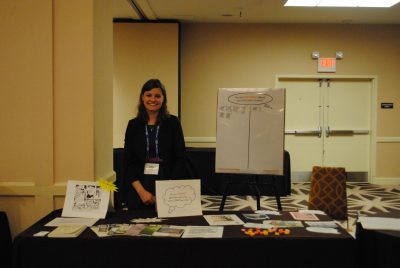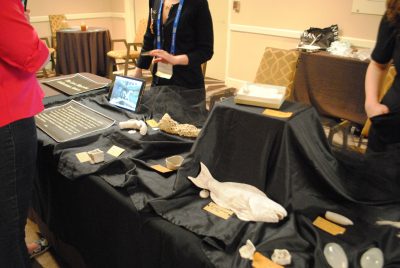Something new is “popping up” in Indy
07 December 2016 – Meghan Hillman

Mickey Mouse History Pop-up, 2015 Annual Meeting, Nashville, TN. Photo credit: NCPH.
The National Council on Public History is offering a new way for attendees to get involved in the 2017 NCPH Annual Meeting in Indianapolis, April 19-22, by opening our first-ever Call for Pop-Ups.
We realize this may seem counterintuitive; surely a pop-up is intended to just, well, pop up? Since 2014, NCPH meetings have featured pre-arranged pop-up exhibits or activities in the commons area of the exhibit hall. In each case, the pop-up emerged as a refreshing opportunity for attendees to interact with presenters in a relatively informal and unstructured way. Previously these pop-ups have been arranged between NCPH staff and members or presenters who have privately expressed interest. Now that we’ve seen some excellent models of successful pop-ups, we think it’s time to open up this presentation opportunity to all.
From NCPH’s perspective, pop-ups are a valuable way to add an additional level of fun and interest to our exhibit hall space. In our quest to emphasize non-traditional conference presentation styles, we’re always pursuing inventive ways for conference-goers to connect and learn from one another. Pop-ups provide additional space for flexible, collaborative experimentation, where attendees get to control the amount of time they spend with the pop-up and can provide immediate one-on-one feedback to its organizers.
A brief history of NCPH pop-ups
The first NCPH conference pop-up, held at the 2014 meeting in Monterey, California, was the brainchild of a group of American University graduate students who wanted to create an exhibit examining the intersection of public history, the environment, human labor, and cultural resources entirely onsite at the conference. This tied in with the meeting’s theme, Sustainable Public History. (Connecting with the conference theme is a great place to start if you are considering proposing a pop-up for the 2017 annual meeting but need a little direction.) The organizers asked attendees to contribute their own experiences–along with images and labels–to the exhibit, Seeds of Change, and awarded prizes for standout entries.

Jenks Museum Pop-up. 2015 Annual Meeting. Photo credit: NCPH.
At the 2015 conference in Nashville, three groups held pop-ups in the exhibit hall. Graduate student winners of the 2015 Student Project Award brought a traveling version of the Jenks Museum, a natural history collection that once existed at Brown University, but has since been lost to time. Participants recreated lost museum specimens in miniature, and these creations joined the home exhibit. A pair of public historians held a pop-up about copyright and fair use, gathering stories and experiences from their fellow public historians and answering questions from attendees. Finally, members of the 2015 working group Free, Separate, Uncertain: Can Public History Play? set participants loose on historical games and asked them to fill in a memory wall about educational play. The Call for Pop-Ups contains more information about each of these examples, including links to History@Work blog posts written by their organizers.
Unfortunately, several potential pop-ups in the works for the 2016 meeting in Baltimore ended up falling through. We missed having them in our exhibit hall, and we think our attendees did too–which is why we’ve decided now is the time to take a more active role in giving your creative, unconventional ideas room to grow.
What, exactly, is a pop-up?
That’s up to you! If you’re interested in putting together a pop-up but aren’t quite sure where to start, those from previous conferences offer good templates. However, NCPH has no specific expectations in terms of format or content. The beauty of pop-ups is that they can be what their organizers need them to be. We merely ask that they be visual and interactive and that they offer attendees a fundamentally different experience than they would get during a breakout or poster session. You can set up shop in the commons area of the exhibit hall for two hours, half a day, or a full day depending on the scope of your project. You can crowd-source an exhibit, share a collection or project you’re working on and ask attendees to evaluate it, or inspire attendees to write, draw, build, or play. The possibilities are endless.
Why should I propose a pop-up?
Pop-ups are ideal for people who are still looking for a way to get on the official Program for Indianapolis, or for anyone who is already presenting as part of a session or working group but thinks that an aspect of their work might really shine in a more interactive and informal format. In the past, pop-ups have been student-friendly opportunities, and they’re also a low-pressure way to dip your toes into presenting at an NCPH conference if you’ve never done so. This format might be especially well-suited to museums and organizations looking to share their programming with public historians and Indianapolis locals who want to help attendees get to know the city better.
Finally, if you’ve had a look at the preliminary Program and think there’s something missing that public historians should be talking about, this is your chance to make it happen. NCPH is your professional organization, this is your conference, and we want it to reflect the topics and issues important to you.
To submit a proposal for a pop-up, please see the Call for Pop-Ups. Proposals are due by January 15, 2017. Program Committee co-chairs Peter Liebhold and John Sprinkle will evaluate proposals and make their selections by early February, a deadline selected to ensure that pop-ups will be listed in the revised digital and onsite printed Program. If you have any questions about pop-ups or just want to float an idea before you officially propose it, send me an email at [email protected].
~ Meghan Hillman is NCPH’s program assistant.



